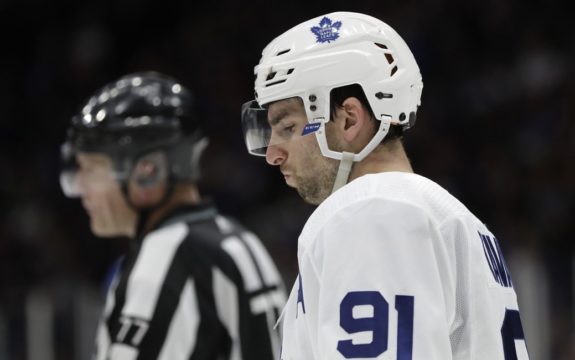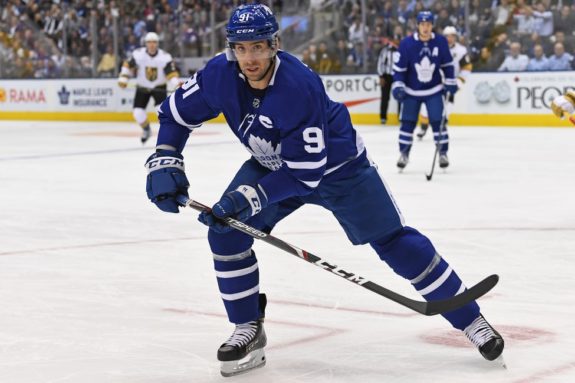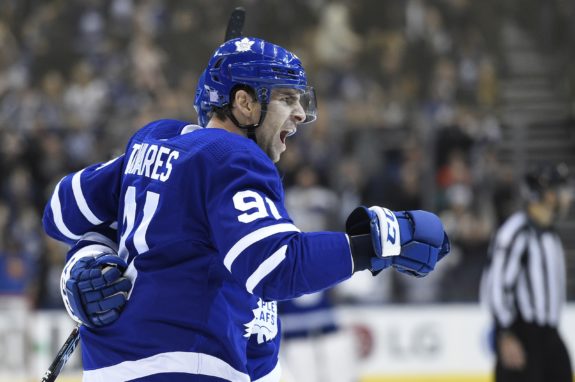Sitting atop the North Division after 33 games, the Toronto Maple Leafs have had a relatively strong first half of the season. There have been some bumps along the way, of course – most notably in the form of goaltender Frederik Andersen and his well-documented struggles – but perhaps the team’s second-biggest worry has come in the form of their captain, John Tavares.
With 9 goals and 27 points so far, the 30-year-old is on pace for just 22 goals and 67 points over 82 games – his least productive season since he was a rookie way back in 2009-10. While we have seen improvements from Tavares on the defensive side, far too many plays are dying on his stick, and that kind of offensive production simply won’t cut it for the $11 million man.

Are the captain’s struggles simply a product of bad puck luck, or at 30 years of age is he truthfully in decline? Here’s why it’s time for the Maple Leafs to start worrying about Tavares.
Tavares Isn’t Producing at 5-on-5
The bulk of hockey is played at 5-on-5 and that’s especially true for the Maple Leafs, who have historically struggled to draw many penalties for one reason or another. This season they sit eighth in the NHL in 5-on-5 minutes per game at just under 50. It’s safe to say that if you’re going to put up big points, you’re going to need to produce at 5-on-5. Unfortunately for Tavares, that simply hasn’t been the case this season.
Related: Maple Leafs’ Sheldon Keefe Opens Up in Rare Personal Interview
In 475 minutes, the Maple Leafs’ captain has scored just five goals (tied for 105th among NHL forwards) and 12 points (tied for 108th). When we adjust for ice time, he looks even worse, ranking 295th in goals per hour (G/60) and 191st in points per hour (P/60). Those are essentially fourth-line scoring rates.

Among 13 Leafs forwards with at least 100 minutes played, he ranks fourth in 5-on-5 ice time yet last in G/60 and 10th in P/60. For comparison sake, 37-year-old Jason Spezza has outscored him in both goals and points even while seeing about half as much ice time per game. Simply put, Tavares has been one of the team’s least productive forwards despite getting his fair share of opportunity.
Tavares Is Struggling to Generate Shots and Chances
The big question, of course, is why has Tavares struggled to produce at 5-on-5? As with most things in hockey, it’s hard to give a concrete answer, but there are a few viable explanations. The most obvious reason would be that he’s generating fewer shots (iSF/60), high danger chances (iHDCF/60), and individual expected goals (ixG/60) than before.

As we can see here, Tavares was an offensive juggernaut in his first season with the Leafs back in 2018-19. That year he scored a whopping 47 goals (including 33 at 5-on-5) while generating a boatload of chances and riding an unsustainable 5-on-5 shooting percentage (S%) of 16.5 percent. Given that his career 5-on-5 S% was just over 11 percent before joining Toronto, it should have been obvious that 2018-19 was going to be an outlier. What no one could predict, however, was how stark the decline would be from 2018-19 to his next season.
Related: Maple Leafs Bolster Goaltending Depth With Vehvilainen Acquisition
Although Tavares scored at a 34-goal, 78-point pace last season, half of his goals and nearly half of his points came on the man advantage. And based on his underlying numbers, it’s clear that he wasn’t the dominant force at 5-on-5 that we saw in his first season with Toronto. All of this is to say that while Tavares has certainly been unlucky this season (as evidenced by his dreadful S%, which we’ll get to), he hasn’t actually generated chances at an elite rate since 2018-19. And since he’s now into his 30s, this may just be who Tavares is now.
Tavares Is Due for a Bounceback
Of course, production alone isn’t the whole story. Puck luck is a huge part of hockey – whether people like it or not – and when a player’s hot or cold you can usually be pretty sure that they’re on an unsustainable shooting bender. The silver lining for Tavares and the Maple Leafs is that the Mississauga, ON, native seems to be due for a substantial bounceback.

As we discussed, Tavares’ 5-on-5 S% is currently sitting at just over five percent – less than half his career mark of 11.49 and by far the lowest rate of his career. His on-ice S% is also at a career-low 6.33 percent – five points lower than 2018-19 and two points worse than last season. So in the way that his 47-goal season in 2018-19 was probably a once-in-a-lifetime performance, it’s likely that Tavares is currently experiencing a once-in-a-lifetime run of bad luck right now.
Adding to the positives, it does seem that he’s turned a corner as of late. Since the beginning of March, Tavares ranks favourably among the Leafs’ big four in terms of goals, points, ixG, and S%.

The cruel reality about hockey, though, is that nothing is guaranteed: Tavares could feasibly continue to generate shots and chances at a solid rate but fail to convert. And while it does seem that his production is picking up, he clearly isn’t the player he was two years ago, and his 8 points in his last 10 games aren’t all that much to write home about.
Related: Maple Leafs’ Handling of Galchenyuk Could Bring Big Returns
The cruel reality for the Maple Leafs is that this is exactly what they signed up for when they inked Tavares to a seven-year, $77 million deal three summers ago. It’s no secret that players tend to decline around 30, and it was always going to be a long-shot for Tavares to play up to his price tag beyond 2021.
The hope for the Leafs now is that they can make good on their gamble while Tavares has still got some juice left in the tank. Adding a dynamic winger like Filip Forsberg or Taylor Hall before the trade deadline could certainly go a long way to getting him back on track, but it’s ultimately up to the captain to steer his own ship.
Stats from Natural Stat Trick